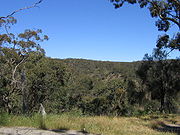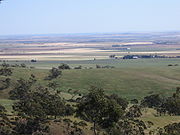
Spring Gully Conservation Park
Encyclopedia


Conservation park
Conservation park is a type of specially protected status for land held by the Crown for conservation purposes.In New Zealand this land is administered by the Department of Conservation and was set up under the Conservation Act 1987. As of 31 March 2005, New Zealand's Conservation parks consisted...
in the Skilly Hills
Skilly Hills
The Skilly Hills is a range of hills which make up part of the Mount Lofty Ranges and forms the Clare Valley, in South Australia's Mid North region. The name comes from the Skilly Creek, which was named by explorer John Horrocks, who was forced to live off skilly, a basic porridge made from flour...
, west of the Clare Valley
Clare Valley
The Clare Valley is one of Australia's oldest wine regions, best known for Riesling wines. It lies in the Mid North of South Australia, approximately 120 km north of Adelaide. The valley runs north-south, with Main North Road as the main thoroughfare....
in South Australia
South Australia
South Australia is a state of Australia in the southern central part of the country. It covers some of the most arid parts of the continent; with a total land area of , it is the fourth largest of Australia's six states and two territories.South Australia shares borders with all of the mainland...
. It provides views to the west across the northern end of the Adelaide Plains
Adelaide Plains
The Adelaide Plains is the area in South Australia between the Mount Lofty Ranges on the east and Gulf St Vincent on the west. The plains are generally fertile with annual rainfall of about per year....
. There are walking tracks ranging from easy to quite steep within the park.
The park was originally created to protect the only stand of Red Stringybark
Stringybark
A stringybark can be any of the many Eucalyptus species which have thick, fibrous bark. Like all eucalypts, stringybarks belong to the Myrtaceae family. In exceptionally fertile locations some stringybark species A stringybark can be any of the many Eucalyptus species which have thick, fibrous...
(Eucalyptus macrorhyncha
Eucalyptus macrorhyncha
Eucalyptus macrorhyncha, commonly known as Red Gum, Red Stringybark, Cannons Stringybark or Capertee Stringybark, is a small to medium-sized tree with rough, thick fibrous and stringy, dark-brown bark....
) trees in South Australia
South Australia
South Australia is a state of Australia in the southern central part of the country. It covers some of the most arid parts of the continent; with a total land area of , it is the fourth largest of Australia's six states and two territories.South Australia shares borders with all of the mainland...
- E. macrorhincha is widespread in eastern Victoria
Victoria (Australia)
Victoria is the second most populous state in Australia. Geographically the smallest mainland state, Victoria is bordered by New South Wales, South Australia, and Tasmania on Boundary Islet to the north, west and south respectively....
and eastern New South Wales
New South Wales
New South Wales is a state of :Australia, located in the east of the country. It is bordered by Queensland, Victoria and South Australia to the north, south and west respectively. To the east, the state is bordered by the Tasman Sea, which forms part of the Pacific Ocean. New South Wales...
. Spring Gully Conservation Park now also protects White Spider Orchids and other smaller plants below the canopy in the grassy woodland
Woodland
Ecologically, a woodland is a low-density forest forming open habitats with plenty of sunlight and limited shade. Woodlands may support an understory of shrubs and herbaceous plants including grasses. Woodland may form a transition to shrubland under drier conditions or during early stages of...
ecosystem
Ecosystem
An ecosystem is a biological environment consisting of all the organisms living in a particular area, as well as all the nonliving , physical components of the environment with which the organisms interact, such as air, soil, water and sunlight....
.
Thousands of the red stringybark trees died following the very dry period from mid 2007 to early 2008 and the record heat-wave of March 2008. The leaves of others died, while the trees survived and later produced epicormic shoots; as of mid 2009 many of these had also died. An apparently small section of the park (20ha) was burned in a lightning-ignited bushfire on 20 November 2009, further stressing some of the trees.

